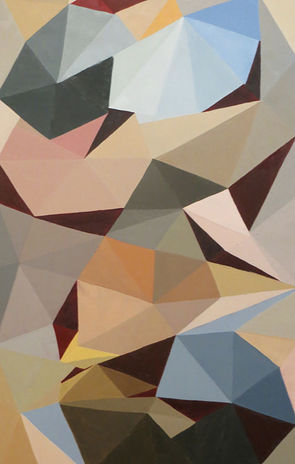Talia Frizzi
Traces: MFA Thesis, 2018
Memory impacts artwork both conceptually and tangibly. Personally, I believe memory can impact artwork because there are inconsistences in the story telling process of gathering information. Memories can be bias, obscured, patchy, or inconsistent with reality. I use cardboard as my medium to represent the fragility of a memory. The manipulation of tearing and collaging the cardboard is symbolic of how memories can become muddled over time to the point when our brain has to piece segments of information together. The stitching in this work is also physical symbol of piecing these memories together. These pieces become what I refer to as a ‘stream of conscious’ that just shows bits and pieces of a story; not necessarily one that is non-bias or entirely coherent. These segments of memory are imagery from events of the past that help form my current identity.
The memories that are detailed in the piece Past Echo are a collection of people, locations, and events that were impactful in my life and I commonly look back to reflect upon in both my artwork and my own mindfulness. These thoughts are a range of comfortable and uncomfortable memories.
While I use cardboard in my work to signify past memories, the use of mirrors symbolizes myself in the present. A single mirror reflects true representation; but by collaging, manipulating, breaking mirrors, and leaving gaps of non-reflective space I am warping the eyes understanding of visual reality. This warping throughout my cardboard work creates ‘present pockets’ through the past memories. My ‘present pockets’ represent remembrance and my current mental exploration of these past thoughts. Each time a viewer comes upon a pocket of mirrors, they are physically able to see themselves similar to how I saw myself when recalling that specific memory. The pockets slowly build up to the Present Echo, in which one can see themselves completely reflected in the present by an abstracted figure that is representative of myself. The viewer is meant to stand in front of the piece and look at the warped reflection to see themselves in a new and different way than they are used to; challenging their brain to piece together information into an image that makes sense to them in real time. I wish for this work detailing my own memories can be used as insightful observation for others as an example of self-discovery and exploration.
Twisted: BFA Thesis, 2016
Abstraction is when an artist can make simple visual information become an experience for the viewer. Abstract art means generating a sensation of emotions through reflective thought and examination of the form; without the need for a narrative. This form achieves illustrating that abstract art can be both simple and complex imagery. This chosen imagery can be expressive or reflective of real life, while not representational. I believe that to thoroughly investigate abstraction, an artist must rely on process and repetition. This art form has unlimited potential; and once finding a style that peeks my interest I continue to explore this relationship until I have successfully articulated the content. Abstraction communicates to the viewer when words are inadequate.
In my triangle series specifically, I generate a visual system of repeated geometric shapes that have personal underlying meanings, emotions, and narratives; but ultimately is not what piece is about. I want the viewer to be the presence of the work as if they are stuck in time of the composition. The viewer will decide what space is in relation to shape, color, and value. The paintings are significant and personal for me but relatable and ambiguous to the viewer. I emphasize the flatness of these triangles and force viewer to find it’s content. The series highlights the arrangement of colors and triangles, which creates an optical affect. Triangles are the only shapes used because the simplicity of their form can be manipulated into creating geometric fluidity. These triangles form color waves that holds a sense of structure. The treatment of the paint varies in this series from smooth, flat matte to raised textures. My color palette is influenced by my interest in flesh and the exploration of skin tones. This exploration can range from earthy neutrals to vibrant reds creating a large variety of color fields.
In my ceramic series I create figures involving simple forms and color. The gesture of the piece is what creates the expression. This bipolar opposite of medium I believe lends itself to discovery. Through an investigation of forms I produce multiple sculptures that portray quirky figures that are meant to be shown and relate to each other. The curved vessel leading into a skinny, knotted top displays the strength of the clay in this delicate and fragile position. These coil vessels are treated with gesso and a flat colored paint to enhance the perception of the sculpture and emphasize form being the most significant variable.





















